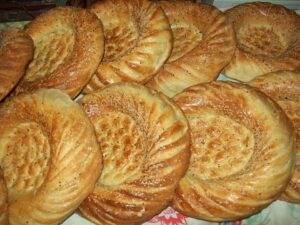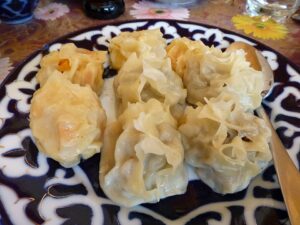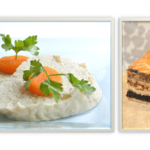This post is the first of a new recurring feature on the site. I will be writing short posts to explain specific Jewish cuisines or dishes that may be less familiar to many readers. These will be less about analysis, and more primers or descriptions. So if you want to know what Bukharian food is, this is your place to find out! And down the road I will do the same for other Jewish communities and dishes.
Who Are the Bukharian Jews?

The term “Bukharian” derives from the former Emirate (and previous to that, Khanate) of Bukhara, based around its central city of the same name. Though presumably the term Bukharian today might apply to anyone living in that city, including non-Jews, most frequently the word is encountered as the ethno-identifier of Jews from the entire region. The main cities they lived in were Bukhara, Samarkand, Tashkent, and Dushanbe.
Depending on how one defines their terms, Bukharian Jews may or may not be considered Mizrachi Jews. As I’ve written previously, the terms Ashkenazi and Sephardi reference Jews who in the Middle Ages lived, respectively, in France/Germany and Spain. Mizrachi means “eastern.” And while Bukhara is situated northeast of Israel, and some therefore call them Mizrachi, to my view the key to that term lies in a community’s connection with Bavel (the Jews of Mesopotamia), the Eastern hub of early rabbinic culture. The Bukharian community was actually one of the more isolated ones through the bulk of its history, suggesting they are one of the communities that is outside the box, neither Ashkenazi nor Sephardi nor Mizrachi. They are simply Bukhari.
Where Are Bukharian Jews Today?

In the early years of Russian control in the region, Jews actually thrived and reached peaks in business and culture. But following the Communist Revolution, things changed, and many fled over the next 50 years or so. There are still small communities that remain in the two countries, but most Bukharaians currently live in the U.S. (with a high concentration in the borough of Queens, NY) and Israel. A smaller but still sizable community lives in England, with even smaller clusters in many other countries. The early Bukharian immigrants to Israel settled largely in a new, and relatively wealthy neighborhood they built for themselves in Jerusalem, still known today as the Bukharian Quarter.
Many restaurants that feature Bukharian cuisine can be found in Queens, with a few more in Israel. One of the better known (and larger) ones in Tel Aviv is called Samarkand. More down to earth in style, and truly a hidden gem, is called Merkaz Asia (“Central Asia”), in the heavily Bukharian neighborhood of Tel Aviv called Shapira. The hole in the wall restaurant abuts a Bukharian style bakery under the same ownership.
What is Bukharian Food?

Generally speaking, Uzbeki cuisine features wheat, with rice as a secondary but still popular grain. Lamb (or mutton more accurately) is the dominant meat, and lamb fat is the primary cooking fat that is used. The national dish of Uzbekistan is plov (pictured at the top of this post), made with rice cooked in rendered lamb fat, adorned with chunks of lamb, grated or slivered carrots, at least one full head of garlic, and sometimes including raisins. Though many Jews make plov in this classic fashion, others include chicken along with their lamb.
The classic bread is called non, is round with a pattern pressed into it, and is classically cooked on the walls of a very hot tandoor oven. A number of bakeries in Jerusalem still sell classic Bukhari non bread every day. Manti (or mantu) dumplings are eaten by Jews and non-Jews, but may be more popular among Bukharian Jews. They are usually meat-filled and typically steamed.
One of the uniquely Jewish foods from Bukhara is osavo (aka oshi savo). It is the main Shabbat stew of the community, using rice and lamb (or sometimes beef or chicken), and flavored with a number of sweet and sour elements: dried prunes and/or apricots, grated green apple, tomatoes, and at times sumac. Another common Shabbat day food is called baksh. It mixes rice with a number of green herbs, ground beef, and chicken livers. The mix is then interestingly cooked in a bag, submerged in liquid, very much like certain elements of Moroccan Shabbat stews.
Shabbat dinner typically begins with fried fish (often carp), served with a garlic and cilantro sauce. Boyjon is a popular starter salad, mixing chopped, charred eggplant with crushed garlic and cilantro, in a dish that is rather similar to Arab babaganoush. As a number of scholars have pointed out, there is no real way to identify how these foods became Bukharian Jewish dishes, while non-Jews of the region don’t heavily consume them. But perhaps Jewish involvement in international trade, and connections with Jews throughout the Middle East and along the Silk Road helped introduce ingredients to their cuisine alone.
To learn more about Bukharian Jewish Food, check out Miriam’s Table: The Bukharian Cookbook, by Lilian Cordell. It is a fairly personal collection, written based on the dishes prepared by Lilian’s mother Miriam. Therefore, a few of the dishes appear to be less traditionally Bukharian, and rather additions that Miriam may have picked up after immigrating to England. But the bulk deliver a comprehensive portrait of the Bukharian Jewish kitchen. Another book that I have yet to see in person, but which looks very comprehensive is Amnun Kimyagarov’s Classic Central Asian Bukharian Jewish Cuisine & Customs.
Know Someone Interested in Jewish Food? Pass This Post Along!







Jill Wheatley
Love this article and the food
What Are Keftes de Prasa? Taste of Jewish Culture
[…] my previous “What is…” post, this one does not look at a sub-community’s cuisine, but at a dish that is widely eaten by […]